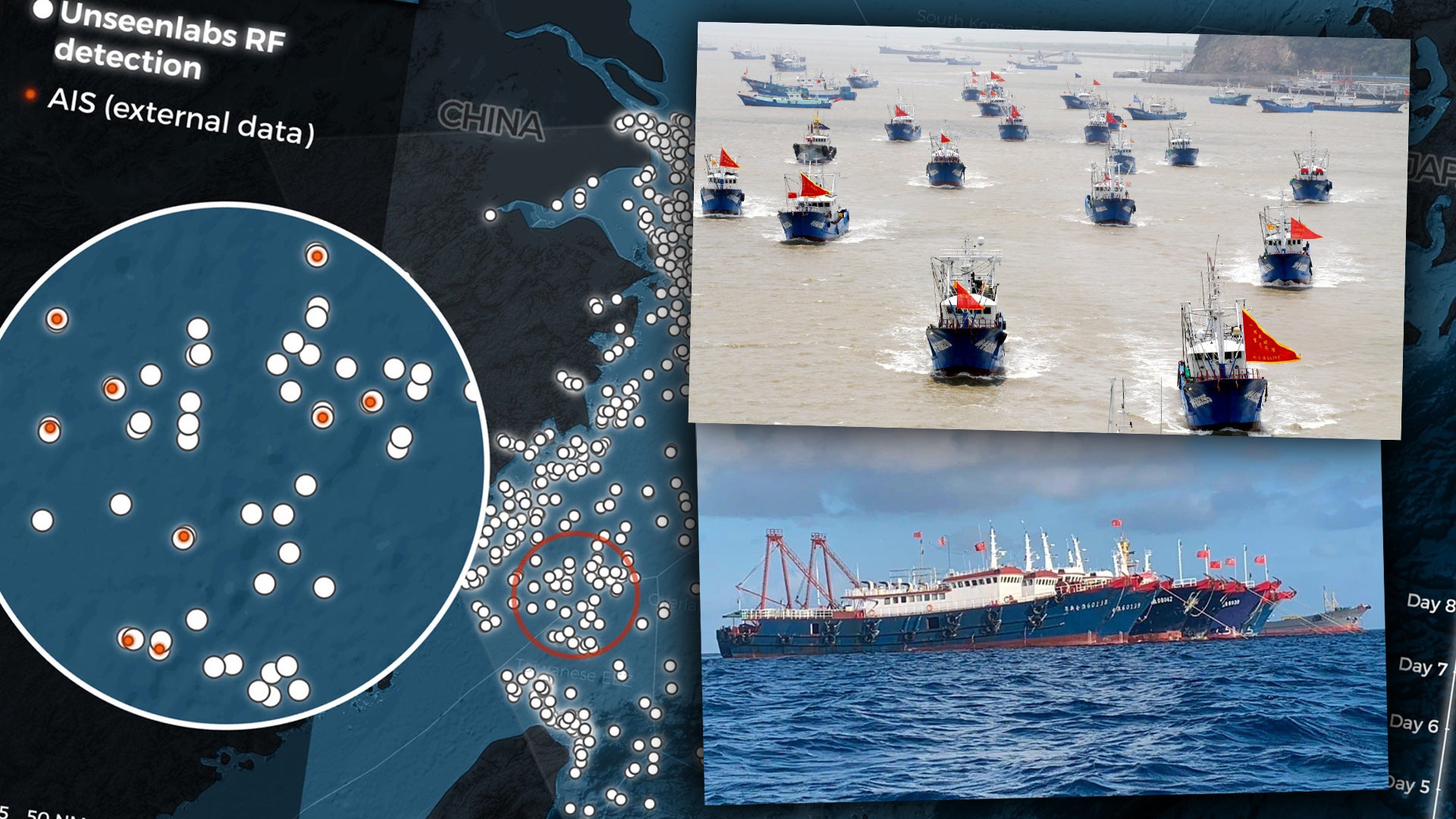
24 Feb Scores Of ‘Dark Vessels’ Belonging To China’s Maritime Militias Are Operating In Contested Waters
A new Chinese law allows for vessels to turn off their transponders in some of the world’s most densely trafficked and tense waterways.
Alarge number of China’s “little blue men,” the irregular maritime militia forces that receive support and training from the Chinese government, have gone dark on traditional maritime tracking systems thanks to a new law. The inability to track these ships is worrisome given the role many Chinese fishing and commercial vessels play in Beijing’s plans to assert itself in the South China Sea and the East China Sea, some of the most hotly contested areas of the Pacific.
A new report underscores the safety and intelligence gaps caused by a cybersecurity and data privacy law passed by China last year which caused a large number of Chinese vessels operating in or near the country’s territorial waters to disappear from global tracking systems. The new data detailing the scope of China’s fleet was published by commercial satellite firm Unseen Labs, which specializes in tracking and identifying radiofrequency (RF) transmissions from space.
In a February 18 press release, the company writes that “most ships are not visible from traditional surveillance systems once they get close to Chinese shores” and that “more than 60% of ships in the area have disappeared” from the automatic identification system, or AIS, the global standard for tracking and identifying ships at sea.
AIS data includes a vessel’s identity and type, its position, course, speed, navigational status, and other safety and positioning-related information. AIS systems were made mandatory for most ships by the International Maritime Organization in 2004, but included provisions that nations “may exempt certain ships from carrying an AIS.”
Ships that are required to transmit AIS include cargo ships weighing 300 gross tons or more engaged on international voyages, cargo ships weighing 500 gross tons not engaged on international voyages, and all passenger ships. Individual nations also have their own AIS laws that pertain to their waters; in the United States, all commercial self-propelled fishing vessels of 65 feet or more in length must broadcast an AIS signal at all times. Most military vessels are not required to transmit AIS signals and do not regularly do so under low-threat conditions, although the U.S. Navy mandated that ships use the system while transiting congested waters after a pair of damaging collisions in 2017. Currently, most AIS systems are radiofrequency based, meaning they only work ship-to-ship or near coastlines. Multiple nations have been launching satellites since the early 2000s to expand the reach of AIS services, which help offer coverage in areas of the open sea far from shore.
To calculate the lack of AIS signals in Chinese waters, Unseen Labs used satellites to detect the RF emissions from ships operating in Chinese waters, and found during one eight-day period that the vast majority of ships operating in the East China Sea were not broadcasting an AIS signal. “As a result, most ships are not visible from traditional surveillance systems once they get close to Chinese shores. In this new context, the AIS system doesn’t provide an accurate picture of traffic at sea.”
It’s unknown how many of these vessels might be part of the country’s irregular maritime militias due to how these fleets operate. Commercial vessels and fishing fleets often coordinate with the People’s Liberation Army Navy (PLAN) in order to harass ships operating in international waters. Not being able to accurately track these vessels, either part of the maritime militias or general fishing fleets, has a significant impact on general transparency and potentially helps China conceal these activities.
Chinese ships’ use of AIS has dropped significantly since the Chinese government enacted the “Personal Information Protection Law of the People’s Republic of China” on November 1, 2021, which blocks a wide range of “personal information” data from being shared with entities or organizations outside of the country. According to National Law Review, the law “imposes stringent requirements on data localization, safeguarding China’s interests in the case of cross-border transfer of personal information.” The full text of the law can be read online here.
A report published last year by Chinese state media giant China Central Television, or CCTV, argues that foreign intelligence agencies use AIS data in order to “have a comprehensive grasp of the number of ships, cargo volume, and export data” in Chinese ports. “The economic intelligence extracted from the data cannot be ignored,” the report states, adding that these “espionage and intelligence agencies have recklessly seized important data resources in [China’s] related fields, causing serious harm to national security.”
A November 2021 Reuters report cited sources that found that the number of ships broadcasting AIS signals in Chinese waters dropped significantly in the weeks following the passage of the law. Chinese officials did not respond to Reuters’ requests for comment.
Even in 2019 before the Chinese government passed the Personal Information Protection Law banning the use of AIS, the Center for Strategic and International Studies noted that “the disconnect between the level of activity and the number of AIS signals being broadcast was staggering.” AIS isn’t the only tracking system affected, however. Unusual GPS spoofing technologies have even been seen in areas surrounding China’s Port of Shanghai, causing the transponders on multiple ships to show up in odd ring-like patterns on land rather than at the port itself.
This lack of AIS use in Chinese waters is dangerous for a number of reasons. For one, six of the world’s ten largest container ports are located in China. That amount of maritime traffic can make it difficult for some radar systems to discriminate between densely packed ships, potentially increasing the risk of collisions. Insufficient AIS data can also exacerbate supply chain shortages by making it more difficult for logistics companies to monitor shipments coming in and out of ports.
The dropoff in ships broadcasting AIS data in Chinese waters is particularly worrisome given the country’s somewhat unique use of maritime militias. In the Department of Defense’s (DOD) 2021 annual report “Military and Security Developments Involving the People’s Republic of China,” the DOD says these militias are “a subset of the PRC’s national militia” and “an armed reserve force of civilians available for mobilization.” The DOD calls these the People’s Armed Forces Maritime Militias, or PAFMM, and notes that these have “played significant roles in a number of military campaigns and coercive incidents over the years, and also supported PRC fishing fleets operating in disputed waters.”
China has been increasingly turning to these “gray zone” tactics to assert its territorial claims in the South China Sea without the use of direct military force. A United States Army War College publication from 2015 defines this gray zone as “the ambiguous no-man’s-land between peace and war, reflecting the sort of aggressive, persistent, determined campaigns characteristic of warfare but without the overt use of military force.” This includes using fishing and commercial fleets to occupy reefs inside other nations’ exclusive economic zones or creating and fortifying artificial islands in international waters.
For these reasons, the China Maritime Studies Institute calls PAFMM “China’s Third Sea Force” and defines them as “a state-organized, -developed, and -controlled force operating under a direct military chain of command to conduct Chinese state-sponsored activities.” According to a 2019 study of Chinese fishing vessels’ behavior conducted by CSIS, “a significant number of fishing vessels in the area forgo fishing full-time to serve as a direct arm of the state through [the] official maritime militia.” Breaking Defense reported that these militia members go through training and “can be activated on demand.”
A RAND Corporation study from 2020 lays out the fact that these militias operate with the direct support of the Chinese Coast Guard (CCG) and PLAN:
PAFMM plays a particularly important role in establishing a de facto Chinese operating presence in disputed areas—in effect, changing the facts on the ground, or at sea, as it were—to challenge counter-claimants’ ability to maintain control over disputed features. These classic “gray zone” operations are designed to “win without fighting” by overwhelming the adversary with swarms of fishing vessels usually bolstered from the rear together with CCG, and possibly PLAN ships, depending on the contingency, in escalatory concentric rings.
Chinese militia vessels have been involved in numerous harassment incidents in recent years, sailing dangerously close to or ramming other ships in an attempt to dissuade military and commercial vessels from other nations from operating in the South China Sea, East China Sea, and Taiwan Strait.
Chinese fishing vessels have harassed U.S. Navy ships, such as in 2009 when the movement of the USNS Impeccable (T-AGOS-23) was blocked by two Chinese-flagged fishing trawlers. Chinese warships have engaged in similar behaviors.
These maritime militias have also been implicated in the past in lasing incidents in the South China Sea, prompting then-Chief of Naval Operations Admiral John Richardson to state in 2019 that the U.S. Navy will respond to aggressive acts conducted by China’s maritime militia in the same way it responds to the PLAN. The Chinese Navy and China’s maritime militias have grown increasingly aggressive towards foreign commercial interests operating in areas the Chinese government claims as its territory. The U.S. Navy has been increasing Freedom of Navigation patrols (FONOPS) in response to Beijing’s territorial claims, and sent two warships to monitor a dispute between Chinese and Malaysian authorities over the operations of a commercial vessel in the South China Sea in 2020.
China is also building artificial islands and arming them with air and anti-ship defense systems. China’s increasingly aggressive presence in the East China Sea and the South China Sea has prompted the U.S. military to devote billions to the attempt to deter its expansion throughout the region. The U.S. has also been publicly calling out China’s bad behavior at sea, an effort which is potentially made more difficult by this new AIS issue.
That deterrence mission could be complicated significantly by the presence of a sizeable fleet of Chinese militia vessels that cannot be tracked, do not have to operate according to military norms, and have the backing of the PLAN.
The shortcomings of AIS, and the Chinese laws that now block its use, are prompting the U.S. and its allies to find new measures to better track maritime traffic. Last year, the DOD launched a competition seeking new tools that use synthetic aperture radar and artificial intelligence to detect and identify what it calls “dark vessels” that don’t broadcast their location to monitoring systems like AIS. Winners were announced earlier this year, and the U.S. Navy now wants to partner with the U.S. Coast Guard and NOAA in order to “operationalize these machine learning algorithms” into the Navy’s SeaVision Maritime Domain Awareness (MDA) program and the Naval Research Lab PROTEUS systems.
As the seas surrounding China continue to be a priority for the U.S. Navy and Department of Defense, the issue of Chinese vessels going dark on AIS is a new hurdle to contend with, and it’s arguably even more of an issue to countries that also have claims to nearby bodies of water. Safety is another obvious concern, but above all else, it is another sign of China moving to obscure open-source data that was once considered a staple of an increasingly globalized world community.

